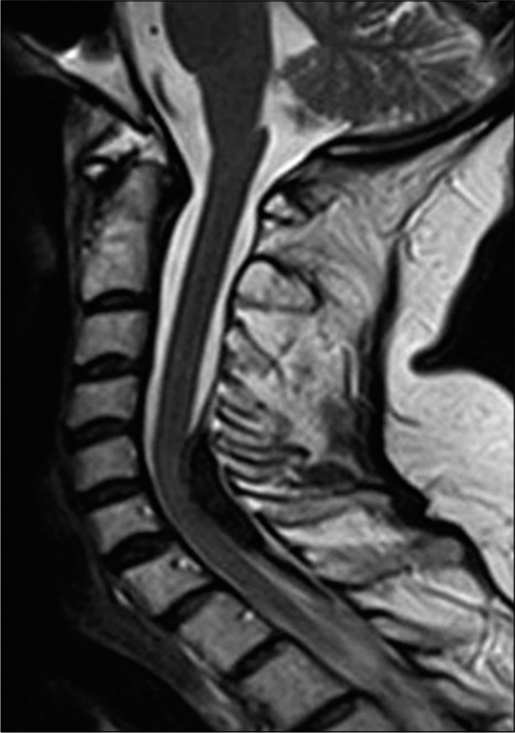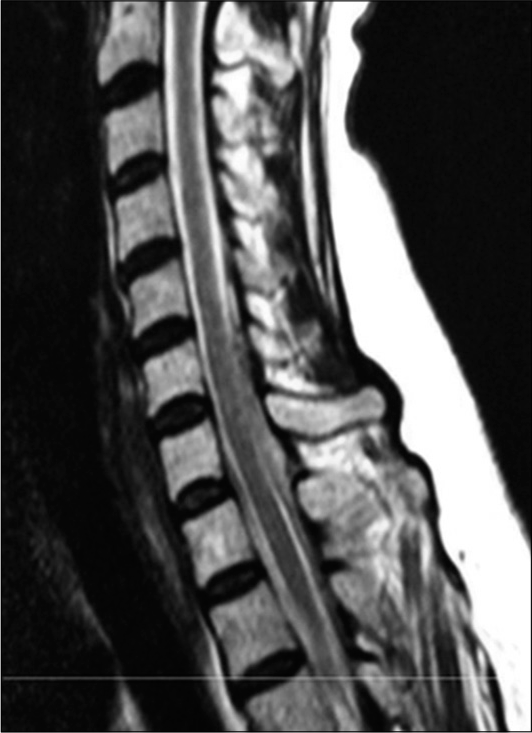- Department of Neurosurgery, University Hospital of Ioannina, Ioannina, Epirus, Greece.
DOI:10.25259/SNI_173_2021
Copyright: © 2021 Surgical Neurology International This is an open-access article distributed under the terms of the Creative Commons Attribution-Non Commercial-Share Alike 4.0 License, which allows others to remix, tweak, and build upon the work non-commercially, as long as the author is credited and the new creations are licensed under the identical terms.How to cite this article: Anastasios Nasios, George Alexiou, Andreas Zygouris, Spyridon Voulgaris. Spontaneous epidural hematoma of the cervical spine in two patients with sarcoidosis. 19-Apr-2021;12:168
How to cite this URL: Anastasios Nasios, George Alexiou, Andreas Zygouris, Spyridon Voulgaris. Spontaneous epidural hematoma of the cervical spine in two patients with sarcoidosis. 19-Apr-2021;12:168. Available from: https://surgicalneurologyint.com/surgicalint-articles/10739/
Abstract
Background: Sarcoidosis is correlated with hematological abnormalities that can result in spontaneous spinal epidural hematomas (EDH). As there is significant risk for permanent neurologic sequelae due to acute cord compression, these lesions often warrant emergent surgical intervention.
Case Description: Two females, 56 and 62 years of age, respectively, both with sarcoidosis on corticosteroids, presented with the spontaneous acute onset of cervical pain, and progressive myeloradiculopathy. Emergent MR scans revealed cervical EDHs with cord compression, respectively, from C5-T1, and C6-C7. Following emergent laminectomies in both cases, patients’ neurological deficits resolved.
Conclusion: Two patients with sarcoidosis at increased risk for spontaneous hemorrhages, presented with cervical EDHs warranting emergent decompressive laminectomies.
Keywords: Cervical spine, Epidural hematoma, Sarcoidosis
INTRODUCTION
Sarcoidosis may lead to coagulation disorders that rarely result in spontaneous spinal epidural hematomas (EDH). Surgical management typically warrants decompressive laminectomies, that often result in favorable outcomes. Here, we present two patients with sarcoidosis who developed spontaneous acute cervical EDHs requiring, emergent laminectomies, resulting in resolution of their neurological deficits.
CASE DESCRIPTIONS
Case 1
A 56-year-old female with sarcoidosis and deep venous thrombosis acutely presented with progressive left hemiparesis (2–3/5 motor deficit, hyperreflexia, bilateral Babinski signs, and left-sided sensory loss of C6, C7 distributions). The cervical MRI showed an acute epidural hematoma from C5-T1 requiring an emergent C6-C7 laminectomy [
Case 2
A 62-year-old female with sarcoidosis suddenly developed left upper extremity weakness (motor grade 4/5), with a left-sided C6 sensory deficit. When the MRI showed an acute C5-C6 EDH, she underwent an emergent C5-C6 laminectomy [
DISCUSSION
Spontaneous spinal epidural hematoma
Spontaneous spinal EDH are rare, representing less than 1% of all spinal space-occupying lesions.They occur with an incidence of 0.1 in 100,000 per year,[
Bleeding disorders with sarcoidosis leading to EDH
Sarcoidosis occurs in approximately 11 cases per 100,000 per year. Patients with sarcoidosis are prone to developing bleeding disorders that predispose them to spontaneous spinal EDH. Emergent spinal MR examinations typically lead to the correct diagnosis and need for surgery depending upon the location, extent, and severity of the EDH and spinal cord compression.[
CONCLUSION
Patients with sarcoidosis are at greater risk for bleeding disorders that may result in spontaneous spinal EDH. In the presence of a significant neurologic deficit, patients should undergo emergent MR scans, and surgical evacuation.
Declaration of patient consent
Patient’s consent not required as patients identity is not disclosed or compromised.
Financial support and sponsorship
Nil.
Conflicts of interest
There are no conflicts of interest.
References
1. Li C, He R, Li X, Zhong Y, Ling L, Li F. Spontaneous spinal epidural hematoma mimicking transient ischemic attack: A case report. Medicine (Baltimore). 2017. 96: e9007
2. Martinez-Perez R, Rayo N. Spontaneous acute epidural haematoma of the cervical spine with an atypical onset resembling ictal symptom. Neurologia. 2020. 35: 507-8
3. Patel R, Kumar A, Nishizawa K, Kumar N. Hemiparesis in spontaneous spinal epidural haematoma: A potential stroke imitator. BMJ Case Rep. 2018. 2018: bcr2017222686
4. Salehpour F, Mirzaei F, Kazemzadeh M, Alavi SA. Spontaneous epidural hematoma of cervical spine. Int J Spine Surg. 2018. 12: 26-9
5. Yao YX, Li MX, Sun LJ. Good outcomes after the delayed removal of an epidural hematoma: A case report. Medicine (Baltimore). 2018. 97: e0341







